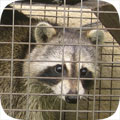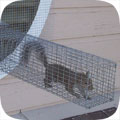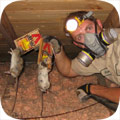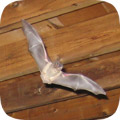- leclaire@wildlifeanimalcontrol.com
Call 24/7 for a free quote:
563-514-4725
Le Claire Wildlife Animal Control
Professional Wildlife Removal Company Servicing Le Claire, IA
If you have a problem with wildlife in your Le Claire home, your best option is to hire a company that specializes in Iowa wildlife removal only. This is a specialty business, and regular pest control companies do not use the proper techniques to solve animal problems. I have spent many years reviewing Iowa and Le Claire, and I recommend the following:
Wildlife Removal Quad Cities
Cell Phone: 563-514-4725
NOTE: If you have a dog or cat problem, call Scott County Animal Services: (563) 388-6655

Wildlife Removal Quad Cities specializes primarily in removing animals from attics of homes and buildings - this includes squirrels in attics, raccoons, and rats or mice in homes. Iowa also has a documented problem with
bats in buildings, and Wildlife Removal Quad Cities is specially trained in bat removal. They also perform general wildlife trapping services, such as the capture and removal of skunks or opossums on the
property. Call 563-514-4725 to discuss your critter problem and schedule a same-day or next-day appointment. Click here to learn more about what prices we charge in 2020.
When hiring a company to solve your wild animal problem, you want these features:
- Specializes in wildlife removal, not pest control
- Fully Iowa and Scott County licensed and insured
- Works 7 days per week (critters don't take weekends off)
- Performs full building inspections: enters and inspects attic
- Performs exclusion repairs, with guarantee against animal re-entry
- Offers cleanup of biohazardous wildlife waste
Wildlife Removal Quad Cities is a full-service Le Claire wildlife removal company. This is very different from a regular Le Claire pest control company. The pest control companies spray poison to kill insects. This is not at all
similar to wildlife removal. Wildlife Removal Quad Cities performs a full inspection of the home or property, and determines why the animal(s) are there, and if inside a building, how the animals got inside. All
animals (including rodents) are trapped and removed, or if possible, removed from the building using special exclusion devices. Once the animals are gone, preventative repairs are essential, and
cleanup is sometimes recommended.
 Le Claire wildlife trapping - it's not as simple as it may seem. It's illegal in Iowa to trap without a license. Trap type is very important and there are many different types, bait is somewhat relevant, trap placement
is vital, and there are dozens of small things that are very important to know.
Safety is a concern. Then once the animal is trapped, it must be removed and dealt with in the proper manner according to Iowa law. We offer Le Claire raccoon removal. Read more about how to get rid of raccoons.
Le Claire wildlife trapping - it's not as simple as it may seem. It's illegal in Iowa to trap without a license. Trap type is very important and there are many different types, bait is somewhat relevant, trap placement
is vital, and there are dozens of small things that are very important to know.
Safety is a concern. Then once the animal is trapped, it must be removed and dealt with in the proper manner according to Iowa law. We offer Le Claire raccoon removal. Read more about how to get rid of raccoons.
 Animals in attics - this is our specialty at Wildlife Removal Quad Cities. Many types of animals like to live in attics. This includes squirrels, raccoons, rats, mice, bats, birds, and even possums. Critters like to go into attics for a safe place to live
and raise their young. Removing animals from attics is very complex work, partly because of the presence of baby animals. If you need Le Claire squirrel removal, we can remove all the squirrels from your attic, and seal out any future ones. Read more about how to get rid of squirrels.
Animals in attics - this is our specialty at Wildlife Removal Quad Cities. Many types of animals like to live in attics. This includes squirrels, raccoons, rats, mice, bats, birds, and even possums. Critters like to go into attics for a safe place to live
and raise their young. Removing animals from attics is very complex work, partly because of the presence of baby animals. If you need Le Claire squirrel removal, we can remove all the squirrels from your attic, and seal out any future ones. Read more about how to get rid of squirrels.
 Rodent control must be done in a very specific way. First off, the most important thing is that all the openings that rats and mice can use to enter a house be sealed. Then all the rodents must be physically trapped and removed.
Never, ever use poison! Most Le Claire exterminators will just use this lazy poison technique to kill rodents, and it causes more harm than good - dead stinky rats, and it doesn't solve the problem. Call us for correct Le Claire rat removal. Read more about how to get rid of rats.
Rodent control must be done in a very specific way. First off, the most important thing is that all the openings that rats and mice can use to enter a house be sealed. Then all the rodents must be physically trapped and removed.
Never, ever use poison! Most Le Claire exterminators will just use this lazy poison technique to kill rodents, and it causes more harm than good - dead stinky rats, and it doesn't solve the problem. Call us for correct Le Claire rat removal. Read more about how to get rid of rats.
 Bat removal is a highly specialized task. Iowa is known to have colonizing bats who often live in buildings. Bats love attics. If not removed, the colony can grow to a very large size over the years. The bat droppings are often corrosive and
cause health risks. The same goes for bird droppings on or in buildings. We perform Le Claire pigeon removal and bird control. But our specialty is Le Claire bat removal. We remove 100% of the bat colony and seal the building so that it's totally bat-proof. Read more about how to get rid of bats.
Bat removal is a highly specialized task. Iowa is known to have colonizing bats who often live in buildings. Bats love attics. If not removed, the colony can grow to a very large size over the years. The bat droppings are often corrosive and
cause health risks. The same goes for bird droppings on or in buildings. We perform Le Claire pigeon removal and bird control. But our specialty is Le Claire bat removal. We remove 100% of the bat colony and seal the building so that it's totally bat-proof. Read more about how to get rid of bats.
 If you have animals inside a house, no job is complete without proper exclusion repairs. If you simply hire a Le Claire trapper who only removes the critters, then the problem will return. You need to hire a Le Claire wildlife control company that identifies 100% of the animal entry points
into your building, and seals them shut with professional repairs. In addition, in many cases animals have left waste or contamination behind, and you'll want a company that can provide professional cleaning services. Wildlife Removal Quad Cities does both.
If you have animals inside a house, no job is complete without proper exclusion repairs. If you simply hire a Le Claire trapper who only removes the critters, then the problem will return. You need to hire a Le Claire wildlife control company that identifies 100% of the animal entry points
into your building, and seals them shut with professional repairs. In addition, in many cases animals have left waste or contamination behind, and you'll want a company that can provide professional cleaning services. Wildlife Removal Quad Cities does both.
The above are just some of the services offered by Wildlife Removal Quad Cities. We also trap and remove animals that destroy lawns, such as moles, or digging animals. Sometimes animals like opossums will live under buildings, steal pet food, raid garbage cans, etc.
Read about how to get rid of opossums. Skunks commonly live under sheds or decks, and set up a den. We can trap and remove them without them spraying. Read about how to get rid of skunks. Wildlife Removal Quad Cities
also provides dead animal removal in Le Claire. If you need help with any other wildlife conflict, from a fox, beaver, groundhog, or any other critter, we can solve it. We also do Le Claire snake removal - most of the snakes in Iowa are not venomous, but
call us if you want safe removal, or read about how to get rid of snakes in Le Claire. And remember, we are a private business, not Scott County Animal Control Services, so if you have a dog or cat problem, call the County at (563) 388-6655.
Scott County animal services does not handle any wildlife issues.
Wildlife Removal Quad Cities: 563-514-4725
Le Claire Pricing Info For Year 2020
 Every wildlife removal situation is different, from the species of animals involved, the location of the animal inside a house or outside, the extent of repairs or cleanup, etc. It's impossible to give one-size-fits-all prices. Examples MIGHT include:
Every wildlife removal situation is different, from the species of animals involved, the location of the animal inside a house or outside, the extent of repairs or cleanup, etc. It's impossible to give one-size-fits-all prices. Examples MIGHT include:
Small Job: For example, a one-stop job to remove an animal in the yard: $100 on up
Medium Job: For example, getting critters out of your house with minor repairs: $300 on up
Large Job: For example, a project involving many service trips and complex work: $500 on up
Give us a phone call now and tell us about your wildlife issue and we will be able to give you a price estimate over the phone. If you're cool with it, we can schedule a same-day or next-day appointment if you like. Our prices are fair, and a good value because we do the job right, the first time.
Le Claire Wildlife Tip #1:
Where do coyotes live? Do more coyotes live in urban areas, or wild areas?
The population of the coyotes are more in North America. The creatures roam the forests as well as the plains, mountains, and deserts of US, Canada, Mexico and even the tropical climax.
Given their adaptive nature, coyotes can afford to live anywhere including large areas populated by humans. This is the reason why they are found in large cities as well. They have a central den where they mark with their scents. The den is basically for breeding their young and sleeping. The scents are put to scare away other coyotes. The den could be anything ranging from a burrow dug in the ground, a hideout in the trees, bushes etc. The mother is charged with the duty of moving the pups to safety should she sense any danger.
Coyotes can live in any habitat but they do prefer open areas like the deserts. They live mostly in packs but this does not mean there are no solitary coyotes. In the urban areas, these animals stick to the wooden patches where they can hide from humans. They frequent all areas except residential, industrial and commercial areas where it is perceived to be filled with people.
As long as there is food, a coyote can live anywhere. In cases where food becomes scarce, they have to travel for miles in search of food and in doing this, they come in contact with humans. The frequent contact would cause them to get used to the presence of humans, that is why they can barge into any compound and feed on the livestock therein.
ARE COYOTES MORE IN THE WILD OR URBAN AREAS?
Over the last one hundred years, coyotes have grown in number and migrated to urban areas. With the clearing of forest trees, the coyotes have been given more open spaces to exploit. With each fallen tree, the coyotes move closer to humans. It is almost inevitable since their natural habitats are being demolished. Every year they get closer to humans, scavenging for food in their refuses and storming their yards. Killing them does little to reduce their population and capturing them for migration does not work either.
It is true that the population of these creatures in the urban areas is becoming alarming, however, there is no definitive proof that their populace in the urban areas is more than that of the wild.
Le Claire Wildlife Tip #2:
Iowa Wildlife Information:
Iowa State bird: Eastern goldfinch
State amphibian: North American bullfrog
State fish: Channel catfish
Iowa is a central state in the Midwest, and its location has given it the nickname "America's heartland". Despite being a naturally flat state which used to have plentiful forests, Iowa has given up much of its natural habitats in favor of agriculture. Now, forests only cover 7 percent of the entire state, often in the river valleys only where farming isn't practical or easy. Thirty percent of the state is still grassland, but only 1 percent of that 30 is original prairie land. More than half of the state-at 60 percent-is active farmland. The weather in this region is warm and humid during the summers with cold, snowy winters. Thunderstorms are common on a daily basis in the warm weather.
Unlike other states with grasslands, Iowa no longer has many of the large grazing creatures that loved to live on the plains. Elk and bison have long since been extirpated from the state due to heavy deforestation and land conversion. Only white-tailed deer remain, and these were once wiped off Iowa soil as well. The species was re-introduced and has thrived, but it is still uncommon in some areas.
Despite the lack of large grazers, predators have fared better in Iowa that in other states. For a while, there was thought to be no evidence of mountain lions or gray wolves, but the large cats have been making a comeback. Experts feel there may now be a breeding population in the state. Smaller predators, like bobcats and coyotes, live off the plentiful small animals that live around the countryside. There are plenty of rabbits, prairie dogs, and raccoons to keep the carnivores happy.
An abundance of small animals means an abundance of pest animals, and Iowa is no exception. The state has raccoons, bats, squirrels, mice, rats, and opossums. Spotted skunks are protected by the state, but they can still become pest animals.
Unfortunately, Iowa has lost many of its native animals due to the progressive nature of humans. A number of animals are on the endangered species list including bald eagles, flying squirrels, bats, certain owls, and a number of lizards, insects, fish, and reptiles. While the original agriculture move ousted many of the state's species, Iowa is taking steps to protect the remaining wildlife.
You can always call Wildlife Removal Quad Cities, any time of day, at 563-514-4725, for a price quote for Le Claire wildlife control services. I am confident that this is the best choice amongst wildlife removal companies in Le Claire, IA.





































